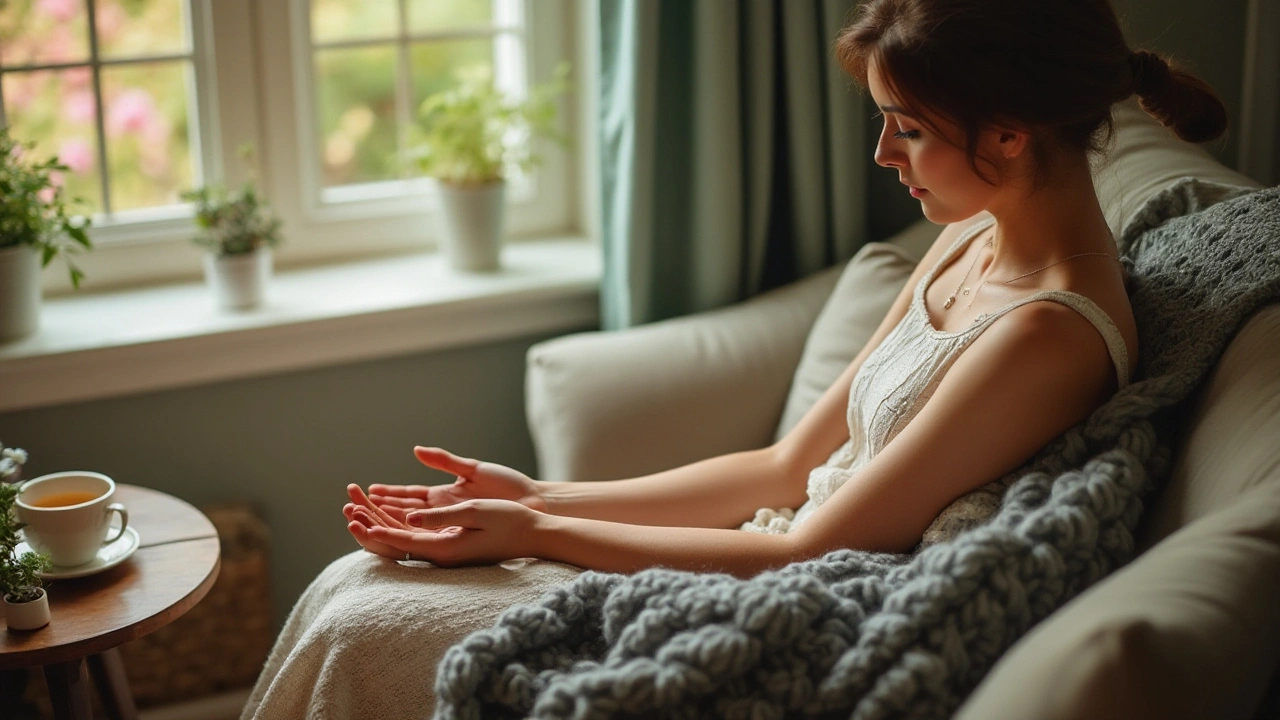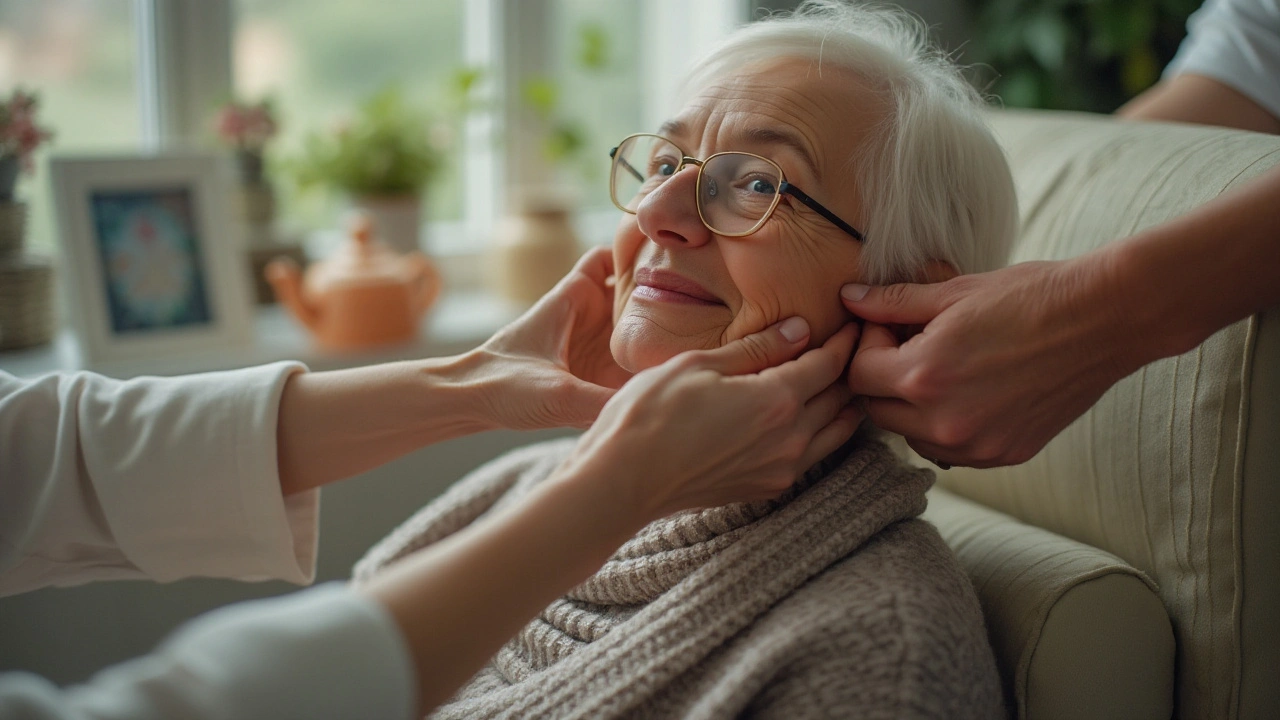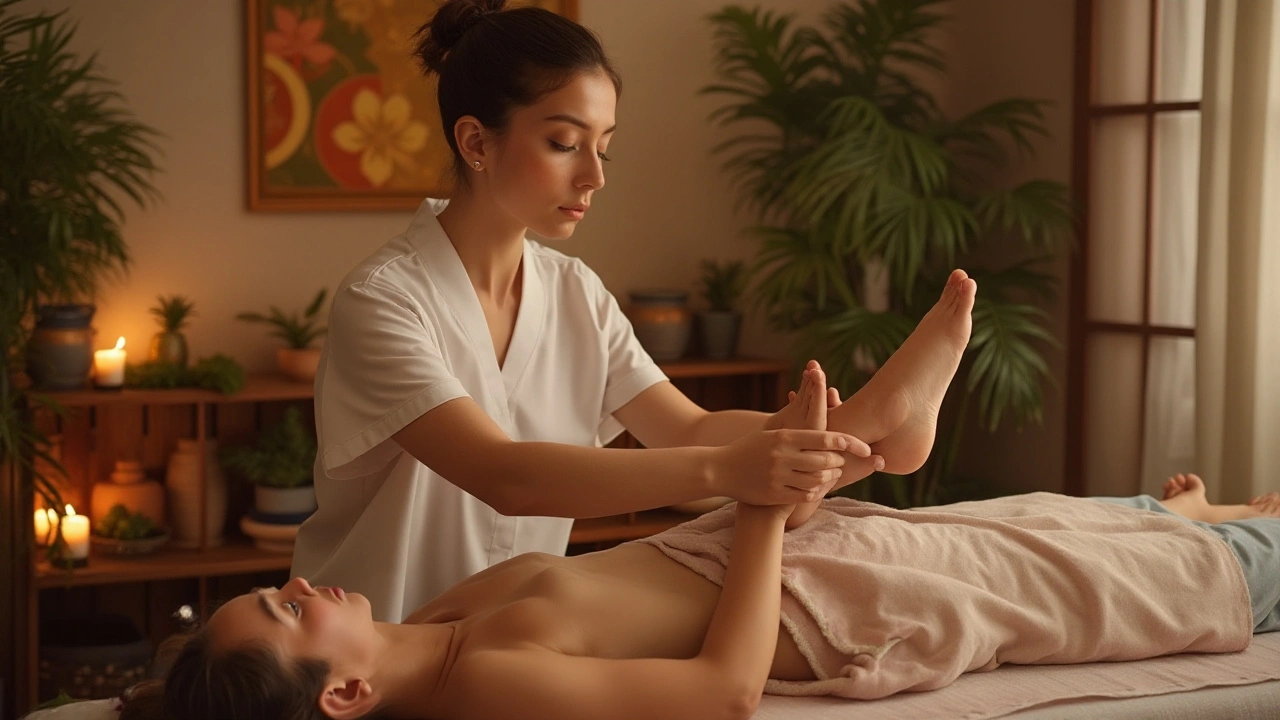Reflexology, a holistic therapy with roots tracing back to ancient China and Egypt, emphasizes the connection between specific points on the feet, hands, or ears and various parts of the body. This practice, often referred to as zone therapy, aims to promote relaxation and stimulate the body's natural healing abilities.
By applying pressure to particular areas, reflexologists believe they can improve circulation, reduce pain, and balance the body. Reflexology is not just about pressing spots on your feet; it's about understanding the intricate relationships between your feet and your overall health. Curious to learn more? Let's dive into the fascinating world of reflexology and uncover the myriad of benefits it has to offer.
- History and Origins
- How Reflexology Works
- Health Benefits
- Common Reflexology Techniques
- Tips for Practicing Reflexology at Home
History and Origins
Reflexology boasts a rich history, finding its roots in the ancient civilizations of China and Egypt. This ancient therapeutic practice is believed to have been used as far back as 2330 BCE. In fact, a wall painting in the tomb of an Egyptian physician, Ankmahor, also known as the “physician’s tomb,” depicts people receiving foot and hand massages, suggesting the early use of this technique.
The Chinese have also contributed significantly to the development of reflexology. Traditional Chinese medicine, which includes reflexology, is based on the belief in Qi (pronounced “chee”), the vital energy that circulates through the body. According to ancient Chinese medical texts, blockages or imbalances in Qi could lead to illness. By stimulating specific points on the feet and hands, practitioners believed they could unblock and correct these energy imbalances, promoting better health.
In the early 20th century, this ancient practice began to take shape in its modern form thanks to the efforts of Dr. William Fitzgerald, an American ear, nose, and throat specialist. He introduced 'zone therapy,' which mapped the human body into ten vertical zones. Each zone correlated parts of the body to specific areas on the hands and feet. Dr. Fitzgerald's work laid the foundation for modern reflexology as we know it today. He documented his findings and shared them through his book, "Zone Therapy or Relieving Pain at Home," making reflexology accessible to the general populace.
By the 1930s and 1940s, Eunice Ingham, a physiotherapist, expanded on Dr. Fitzgerald’s work. She further developed the foot maps, which are still used in contemporary reflexology practice. Her book, "Stories the Feet Can Tell," published in 1938, remains a significant text in reflexology literature. Ingham’s meticulous documentation includes numerous case studies demonstrating the effectiveness of reflexology.
Did you know that reflexology was also practiced by Native American tribes? Cherokee tribes, in particular, employed similar techniques as part of their healing rituals. They believed in a holistic approach to health, which encompassed physical, spiritual, and emotional healing. This aligns closely with the principles of modern reflexology, emphasizing the interconnectedness of the body and the importance of balance.
“When our feet hurt, we hurt all over.” – Socrates
It wasn’t until the latter half of the 20th century that reflexology started gaining significant recognition and acceptance in the West. Today, reflexology is practiced worldwide and recognized as a legitimate complementary therapy. It has found its place in holistic health centers, spas, and even in some medical settings, thanks to its non-invasive nature and the growing body of evidence supporting its benefits.
The enduring appeal of reflexology lies in its simplicity and effectiveness. By understanding the historical context and origins of reflexology, one can better appreciate its significance and the profound impact it can have on overall well-being. Dive deeper into the next sections to unravel how reflexology works and the myriad benefits it offers.
How Reflexology Works
Understanding how reflexology works involves recognizing the fundamental principle of reflex points. These are specific areas on your feet, hands, or ears that correspond to different organs and systems within your body. The practice is grounded in the concept that energy pathways, often referred to as 'zones', run throughout the body. Reflexologists use their hands to apply precise pressure to these zones to unblock energy flow, aiming to promote balance and healing.
Imagine your body as a map where each part is represented by a corresponding spot on your feet or hands. By stimulating these points, reflexologists believe they can address health issues related to those specific parts. For example, the tips of your toes reflect your head, while the ball of your foot is linked to your heart and chest. Applying pressure on the heel may impact your lower back and intestines. It’s a unique way of viewing health that integrates the whole body rather than focusing on isolated symptoms.
The nervous system plays a significant role in reflexology. Applying pressure to reflex points is thought to send calming signals to the central nervous system, inducing a relaxed state. This connects directly to the body’s ability to heal itself. By lowering stress levels and promoting relaxation, the body can better manage pain, improve circulation, and boost immune function. A relaxed body is a healthy body, and reflexology aims to create that state of relaxation through targeted foot massage.
One intriguing aspect of reflexology is its repertoire of techniques. The most common methods involve thumb-walking, where the therapist walks their thumb across the foot in a caterpillar-like motion, and finger-walking, which uses a similar technique with the fingers. These methods bring comfort and care, often leaving patients feeling revitalized. Reflexologists also use rotation-on-a-point, which involves pressing firmly on a reflex point and slowly rotating the applied pressure. Each technique is carefully designed to offer the most therapeutic benefits.
Healing through reflexology doesn’t stop at physical ailments. It is also effective for emotional and psychological health. Some studies show that reflexology can alleviate symptoms of anxiety and depression. The practice can trigger the release of endorphins, often referred to as the body's natural 'happy hormones'. These hormones help improve mood and overall sense of well-being. A gentle session of reflexology has the potential to transform an individual’s day by lifting their spirits and relaxing their mind.
According to the International Institute of Reflexology, “Reflexology is a supportive therapy that works on the foot to heal the whole body.” This statement underpins the holistic nature of the practice, where the focus is on treating the person as a whole rather than addressing isolated symptoms.
Lastly, modern research supports some claims about reflexology. Scientific studies have demonstrated beneficial outcomes, such as lower blood pressure and improved kidney function in patients receiving reflexology treatments. However, it is important to note that while reflexology can support conventional medical treatments, it should not replace them. It's always wise to consult with healthcare professionals before starting any new form of therapy.

Health Benefits
When discussing the health benefits of reflexology, it's important to dive into how this age-old practice can positively impact various aspects of our well-being. Reflexology is more than just a foot rub; this therapy works by stimulating reflex points on the feet, which correspond to different organs and systems within our bodies. Many people turn to reflexology to relieve stress, which is one of its most recognized benefits.
Stress is not only mentally draining but also deeply affects physical health. Reflexology sessions aim to reduce anxiety by promoting relaxation. When you engage in a reflexology session, the repetitive hand movements and applied pressure can significantly calm the nervous system. Many enthusiasts find that they walk away feeling rejuvenated and less burdened by their worries.
Apart from alleviating stress, reflexology is believed to enhance blood circulation. Improved circulation can lead to a decrease in muscle tension and soreness, and a quicker recovery from injuries. The pressure techniques employed in reflexology encourage the blood vessels to operate more efficiently, thus allowing for better distribution of oxygen and nutrients throughout the body.
One fascinating benefit of reflexology is its ability to help with pain management. The technique is often used as a complementary therapy for chronic pain conditions like arthritis, migraines, and lower back pain. By targeting specific reflex points that correlate with these affected areas, reflexology can alleviate pain and discomfort without the need for medication.
According to the National Center for Complementary and Integrative Health, "Research has shown that reflexology can significantly reduce pain and improve physical functioning in chronic pain patients."
Another benefit worth mentioning is its role in improving digestion. Those suffering from digestive issues such as irritable bowel syndrome or constipation have reported relief after undergoing reflexology. By stimulating the reflex points associated with the stomach and intestines, this therapy aids digestion and promotes a healthy gut.
Reflexology also promotes better sleep. Insomnia or other sleep disorders are common complaints in our fast-paced society. The calming effect of reflexology sessions can ease individuals into a state of deeper relaxation, enabling better sleep quality and duration. Regular sessions have shown to create a consistent sleep pattern, which is crucial for overall health.
Moreover, reflexology supports the immune system. Frequent sessions are believed to improve lymphatic drainage and increase white blood cell count. This makes the body more effective at fighting off infections and illnesses. Additionally, it could potentially speed up the recovery process for those battling sickness or recovering from surgery.
Lastly, reflexology has been touted for its benefits in balancing hormones. This can be particularly beneficial for women dealing with menstrual problems or the symptoms of menopause. The targeted pressure points help in regulating hormone production and providing relief from associated symptoms like mood swings or cramps.
Common Reflexology Techniques
Reflexology offers a variety of techniques, allowing practitioners to tailor the treatment to individual needs. Understanding these methods can enhance the therapy experience, whether you're receiving professional sessions or practicing reflexology at home.
One widely-used technique is the thumb walk. In this method, the practitioner applies pressure using the thumb and moves in a walking or crawling motion across the reflex points on the foot. This approach helps in systematically covering different pressure points and ensuring even stimulation. Another technique, known as finger walking, operates on a similar principle but utilizes the fingers instead of the thumbs. This method is particularly effective for areas that are too sensitive for the stronger thumb pressure.
The hook and backup technique is another common practice in reflexology. This involves hooking the thumb or finger into a reflex point and gently pulling back. This method is especially beneficial for loosening tight or congested reflex points that may be linked to problem areas in the body. Reflex circles, where the practitioner uses circular motions to stimulate the reflex points, are also popular. This technique is often used for relaxation and to enhance the body's natural healing process.
In addition, reflexology includes the technique of rotational pressure, where a rotating motion is applied with the thumbs or fingers. This method aims to stimulate blood flow and relieve tension in specific areas. Sliding or rubbing techniques, where the practitioner glides their fingers or thumbs along the feet, can help in soothing and warming up the area before applying more focused pressure.
For beginners, it’s essential to start gently and slowly increase the pressure as needed. Understanding the feedback from the individual receiving the treatment is crucial in adjusting the techniques for maximum benefit. As Dr. Dwight C. Byers, a leading authority in reflexology, has mentioned,
“The art of reflexology is about applying the right type of pressure and understanding what the body communicates.”
Using specific tools can also enhance the reflexology experience. For example, wooden sticks or rollers can be used to apply pressure to the reflex points. These tools help in maintaining consistent pressure and can be especially useful for self-practice when it might be challenging to use hands effectively. Regular practice with these techniques can lead to better reflexology sessions and more profound health benefits.
A study published in the Journal of Alternative and Complementary Medicine highlights the impact of reflexology in reducing symptoms of various conditions like migraines, back pain, and digestive issues. By understanding and applying these common reflexology techniques, you can unlock the potential benefits of this ancient healing art, improving health and wellness significantly.

Tips for Practicing Reflexology at Home
Reflexology can be a powerful way to enhance your well-being from the comfort of your own home. To get started, you'll need a quiet space, a comfortable chair, and maybe some soothing music to set the atmosphere. Begin by cleaning your feet thoroughly to ensure they're free of dirt and sweat. A good soak in warm water can help prepare your feet, making them more receptive to the pressure you'll be applying.
First, understand the basic reflex points. Each foot corresponds to different organs and systems in your body. For instance, the tips of your toes are linked with your head and sinus areas, while the arch of your foot connects to your digestive system. You might want to use a reflexology chart for reference, as this can guide you in identifying the specific areas to focus on.
Finding the right technique is essential. Use your thumb or fingers to apply gentle but firm pressure. Press into the skin and then release. Some people like to use thumbs to make small, circular motions, while others prefer a more straightforward pressing approach. Whichever method you use, be sure to apply consistent pressure for about 5 to 10 seconds before moving to the next spot. If you feel pain, you may be pressing too hard, so ease up if necessary. Remember, reflexology should be relaxing.
"Our feet contain over 7,000 nerve endings, making them perfect for reflexology," says Dr. Mildred Carter, a renowned reflexologist and author.
This brings us to the importance of consistency in reflexology. Doing a session once isn’t going to yield the same benefits as regular practice. Aim for at least 15 minutes per session, a few times a week. The idea is to gradually build it into your routine so your body becomes attuned to the practice, and you can start enjoying its benefits more fully.
Another tip is to use tools to enhance your practice. Reflexology balls, wooden sticks, or even a simple golf ball can add variety and effectiveness to your sessions. Roll these tools under your feet to apply pressure in ways that your fingers might not be able to achieve. Doing so can help target deeper layers of your muscles and tissues, reaching points that are not easily accessible.
Adding Essential Oils
Incorporating essential oils can elevate your reflexology experience. Essential oils like lavender, eucalyptus, or peppermint have properties that relax muscles and relieve tension. Dilute a few drops of your chosen oil in a carrier oil, then massage it into your feet before starting your session. This not only makes the massage more pleasant but also helps the oil’s therapeutic properties penetrate your skin more effectively.
Keep a Reflexology Journal
Finally, keep track of your progress by maintaining a reflexology journal. Note down the areas you focused on, the techniques you used, and any feelings or changes you experienced. This can help you identify patterns over time, giving you insight into what works best for your body’s unique needs. It's a great way to make your sessions more intentional and personalized.
Practicing reflexology at home can be an enriching addition to your wellness routine. It’s easy to get started, and the potential health benefits make it well worth the effort. So why not give it a try? Your feet—and your whole body—will thank you.


 Health and Wellness
Health and Wellness